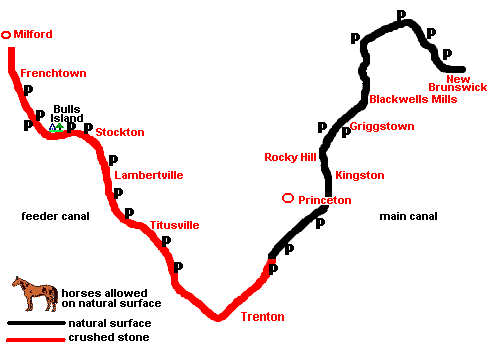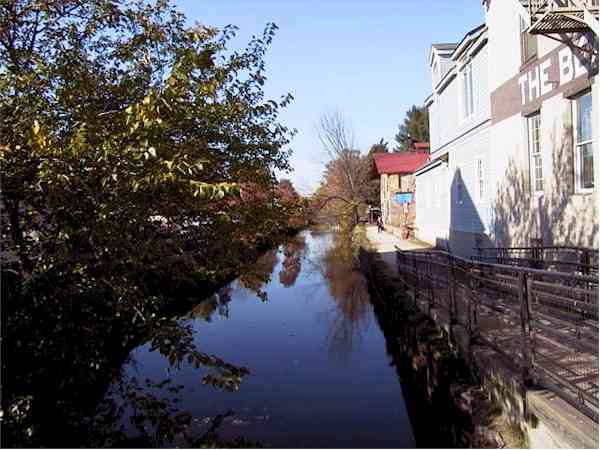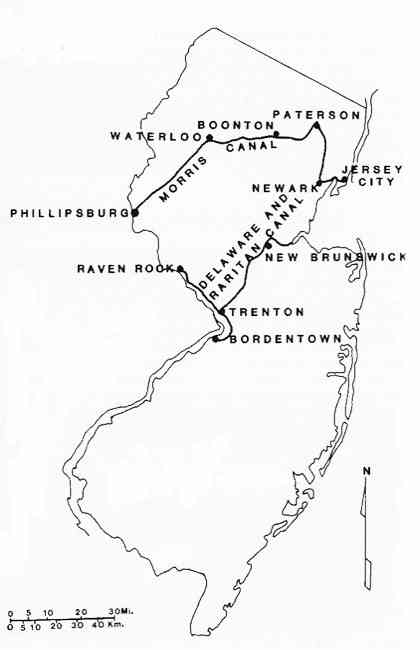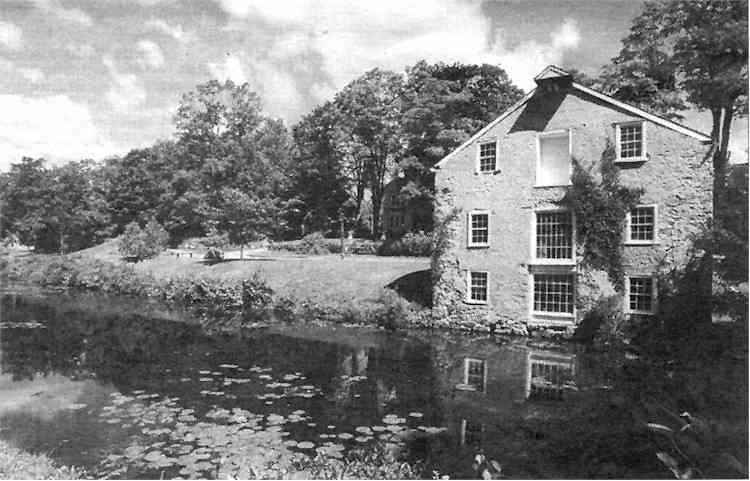How to Climb a Mountain with a Canal
New Jersey Canal SystemAll the performances of human art, at which we look with praise or wonder, are instances of the resistless force of perseverance; it is by this that the quarry becomes a pyramid, and that distant places are united with canals. If a man was to compare the single stroke of the pickaxe, or of one impression of the spade, with the general design and the last result, he would be overwhelmed by the sense of their disproportion; yet those petty operations, incessantly continued, in time surmount the greatest difficulties, and mountains are leveled and oceans bounded by the slender force of human beings. - Samuel Johnson
This is one of New Jersey's most popular trails, in part because of the history associated with it. There are 19th century bridges, bridge-tender houses, cobblestone spillways and hand-built stone-arched culverts. The upper portion of the feeder canal follows the Delaware River through historic towns such as Frenchtown, Stockton and Lambertville. Horses are not permitted on the feeder canal trail. Source: trailsfromrails.com/delaware_raritan_trail.htm
View of canal and tow path looking north - Lambertville, New Jersey The stone entrance archway of the Morris Canal is visible on the New Jersey shore directly opposite the Guard Lock of the Delaware Canal. The Morris Canal was the most unique of America's towpath waterways. Designed to carry coal from the Lehigh Valley to New York harbour, it utilised a series of 23 water-powered inclined planes along with 34 locks (including tide locks, guard locks and feeder locks) to cross New Jersey. It was completed in 1831 between Newark and Phillipsburg (where it connected with the Lehigh Navigation and Delaware Canal by means of an outlet lock and cable ferry which crossed the Delaware River). The Morris Canal enjoyed its first full boating season in 1832. In 1836, it was extended to Jersey City. Its total length, including navigable feeders, was 109 miles. During the 1850's and 1860's the original inclined plane water wheels were replaced with more efficient water turbines. The canal locks had been previously enlarged resulting in a 75-ton navigation limit by 1860. Beginning in the 1840's large amounts of high grade New Jersey iron ore were shipped West on the Morris Canal to the prosperous anthracite iron furnaces of the Lehigh Valley and upper Bucks County. In 1866, traffic on the Morris Canal reached its peak when it carried 899,220 tons of freight. Competition from railroads, however, eroded the canal's role as a coal carrier and in 1871, the Lehigh Valley Railroad secured a long term lease of the Morris Canal. Primarily concerned with utilising the Canal's New York waterfront facilities, the Lehigh Valley Railroad never realised a profit from its acquisition. After 1889 the cable ferry to Phillipsburg went out of use. In 1905 a flood destroyed the Easton outlet lock. By 1915 commercial traffic on the Morris Canal ceased. In 1922 the Morris Canal passed into the hands of the State of New Jersey. The decision was made in 1924 to abandon the Canal and within 5 years the waterway was largely destroyed. In 1929, an abandonment report was issued marking the end of the Morris Canal. Source: canals.org/morris.htm
More on the Morris CanalThe Morris Canal always was a good place for a stroll. The canal's 102-mile meander across northern New Jersey, from Phillipsburg to Jersey City, was walked by every mule driver for every team that pulled a canal boat from 1831 to 1924. However, the canal's towpath also served as a route for recreational rambles during its years of operation. "People did a lot of walking on that canal,'' says James Lee, the noted Morris Canal historian. "I've got pictures of ladies walking along the canal with their white dresses on,'' he said, describing how they carried umbrellas for shade as their long dresses trailed down to their ankles in the fashion of the day. The Morris Canal was the brainchild of Morristown businessman George MacCulloch, who envisioned a commerce route that could surmount North Jersey's rugged terrain to ship coal, iron ore, farm produce and other products across the state. To conquer an unprecedented 1,674-foot change in elevation - 760 feet from the Delaware River at Phillipsburg up to Lake Hopatcong, the summit level, and 914 feet back down to tidewater at Newark Bay - the Morris Canal used a series of locks and a new innovation, the inclined plane. Operated from 1831 to 1924, the Morris Canal was considered an engineering marvel of its time, but, by the end of its life, it had been surpassed by railroads as a shipping route. Although employed on a smaller scale on English canals, the inclined plane was adapted for the Morris Canal and used to conquer changes of elevation anywhere from 35 to 100 feet. The canal boats were floated onto a cradle car, which was pulled out of the water, then up or down on iron rails to the next section of canal. Those iron rails were supported by heavy stone sleepers, which on several of the planes can still be seen, often with a groove worn into them by the thick cable that raised and lowered the cradle car. Lake Hopatcong, New Jersey's largest impoundment, was created from two smaller lakes to be the major water supply for the Morris Canal at its summit level. The dam now in existence was built at the closing of the canal to replace the former dam, and it includes part of the wall of a lock. At each plane, water from the canal's upper level flowed into the headrace flume to the powerhouse, where it dropped 40 to 50 feet to the turbine. The force of a 5-foot diameter column of water dropping that distance, flowing up through the turbine and shooting out of its curved arms, made the turbine spin, powering the cable that pulled the cradle car holding the canal boat on the plane. While some who worked on the canal were rough and tumble types who would frequent taverns along the way, other boats contained whole families. On those family boats, the parents would steer while the children would guide the mules on the towpath. The condition of his team of mules reflected on a canal boat captain. When the team was in poor condition, the boat would not make good time in its journey between Phillipsburg and Jersey City, which took an average of 5 days. The mules - or horses, which also were used - would walk and tow the boat sometimes until 9 or 10 at night, often until reaching a lock or inclined plane where the captain would tie up for the night. The team would be brought to a barn and given fresh hay. While most teams consisted of two animals, occasionally three mules were used so that the trip could be made in 4 days instead of 5. A waste gate allowed water from a stream entering one side of the canal to discharge out the other side. The gate also could be used to completely drain that section of canal for repairs. Source: njskylands.com/hsmorriscanal.htm
The major function of the canals was to move Pennsylvania hard coal to the industrial Source: A Geography of New Jersey: The City in the Garden - Second Edition by Charles A Stansfield Jr 1998
Festival Marks Era of Canal Power
The old Morris Canal still winds behind a general store in Waterloo Village in Byram Township by William Gordon Canal Day FestivalWhen: 11am - 5pm Saturday Looking every inch a canal boatman in his straw hat, suspenders, baggy trousers and interchangeable boots, Roy Justice - the "Traveling Minstrel" - not only sings the songs of the old canal days, he also tells the stories. The songs are ditties like Simon Slick about mules, and Good Ship Calabar, a song of the brawny Irish immigrants who shovelled out the canals of New Jersey and elsewhere. The stories Justice tells in his soft country accent are in the vein of the following charmer:
The canal era in New Jersey spawned hundreds of songs and stories, and canal historian and entertainer Justice will be singing and spinning many of them at Saturday's 6th annual Canal Day Festival at historic Waterloo Village in Byram. The festival is sponsored by the Canal Society of New Jersey. "We're inviting folks to come down and spend a leisurely day enjoying a calmer time when business in New Jersey moved at a mule's pace - two mules to be exact," said Canal Society president Robert Earth. "It was a time when the quiet of the countryside would be broken from time to time by the boat captain's conch shell horn signalling 'ready on the lock, I'm a half-mile away!'" The festival will include tours of canal facilities at the restored 19th century village, a major port on the Morris Canal, which crossed the state from Phillipsburg on the Delaware River to Jersey City on the Hudson, making stops at inland "ports" along the way. Preserved at bucolic Waterloo on the Musconetcong River in Sussex County is a cluster of the Morris Canal's major features. These include a portion of the canal itself, a general store, lock, aqueduct lock, a reconstructed mule bridge, railroad bridge and the cleared 80-foot slope of inclined Plane 4 West that is earmarked for eventual restoration. Guides will be on hand for tours of the canal features, as well as the Canal Society's museum, containing a guest book with names of visiting canal enthusiasts from around the world. All the other facilities at the village will be open to the public, including the grist and saw mills, 15 dwellings, a few late-19th century mansions and the replica Lenape Indian village. At the museum, visitors view a canal video and a working scale model of an inclined plane, as well as photos and paintings interpreting the two major canals of New Jersey, the vanished Morris and the still navigable Delaware & Raritan Canal. Guests can also stop in for authentic canal food at the Towpath Tavern in the basement of Smith's canal store, or enjoy a stein of canal beer, specially micro-brewed for the festival. "Justa Buncha Barrios" will be playing Dixieland, canal songs and other old-time favourites. Travelling minstrel Justice will be found strolling the canal mule path singing its songs, and other favourites of the late 1800s. Visitors curious about his look-alike foot wear will be informed that boots in the 1800s had no "left," or "right," and they were all the same size, making them reusable by other than the original owner. At 2pm the Canal Society will unveil and dedicate new signage along the upgraded canal right of way between Waterloo Village and Saxton Falls known as the Morris Canal Greenway. The signs provide visitors with information on the historical and technical importance of many features of the Greenway. At 2:30pm Canal Society Vice President Brian Morrell of Stanhope will lead a hike along the Greenway west of Waterloo through Allamuchy State Park. For a waterway that exists almost entirely in archival photographs and the fond memories of old-timers, the Morris Canal continues to be a source of fascination among canal buffs in New Jersey and around the world. "It's famous because it was unique, a mountain climber," says Society President Barth. "Over the canal's 102-mile length it went through elevation changes totalling 1,674 feet. Most of these changes were overcome by 23 water-powered 'inclined planes' that moved canal boats in cradles up and down the plane on rails. Source: The Star-Ledger Friday 8 June 2001; photo credit Star-Ledger files from 1998
Source: Daily Record Morris County edition classifieds Sunday 20 January 2002
For more articles on New Jersey including facts, census data, complex highway interchanges, photos, transit plans, politicians, geology, canals, regions, governance, flora and
fauna click the "Up" button below to take you to the Table of Contents for this section. |
 Animals
Animals Animation
Animation Art of Playing Cards
Art of Playing Cards Drugs
Drugs Education
Education Environment
Environment Flying
Flying History
History Humour
Humour Immigration
Immigration Info/Tech
Info/Tech Intellectual/Entertaining
Intellectual/Entertaining Lifestyles
Lifestyles Men
Men Money/Politics/Law
Money/Politics/Law New Jersey
New Jersey Odds and Oddities
Odds and Oddities Older & Under
Older & Under Photography
Photography Prisons
Prisons Relationships
Relationships Science
Science Social/Cultural
Social/Cultural Terrorism
Terrorism Wellington
Wellington Working
Working Zero Return Investment
Zero Return Investment
 The Delaware & Raritan trail is over 60 miles long, but the portion with
crushed stone is approximately 33 miles long.
The Delaware & Raritan trail is over 60 miles long, but the portion with
crushed stone is approximately 33 miles long.

